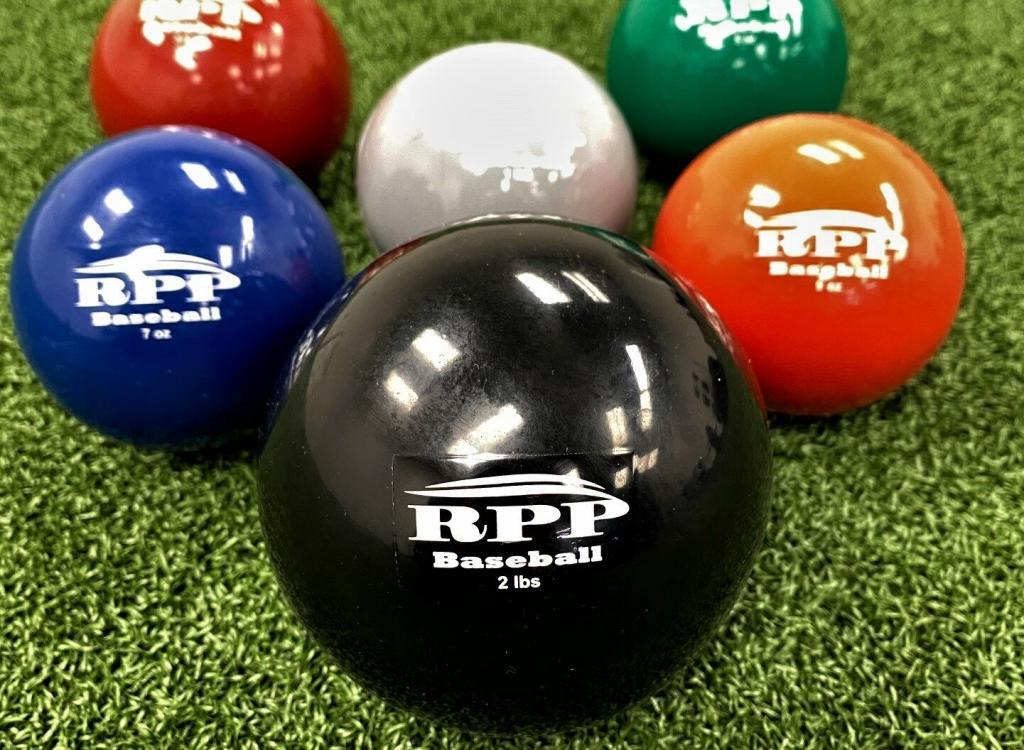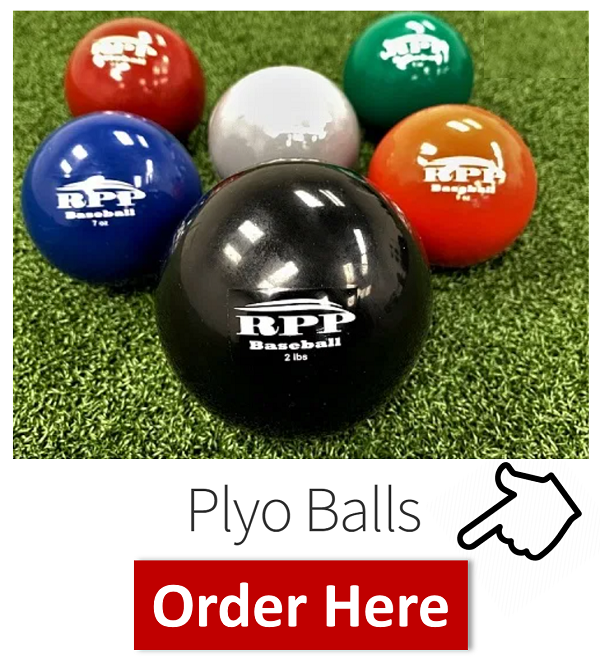Throwing programs often include Plyo Balls drills for improving pitching mechanics and overall movement patterns. They have been around for quite some time and we’re not here to re-invent the wheel. However, we’re going to review which ones we recommend and what has worked, through trial and error, for our pitchers over the years. Here we go…
-
- Our Recommended Plyo Balls drills
- Their Purpose
- What issue they’re used to Improve
- Performance cues
- Sets and reps
Our Recommended Plyo Balls Drills
-
- Reverse Throws
- Marshalls
- Walking Torques
- Lead Leg IR
- Step Behind Drill
- Step Back Throw
- Rocker Drill
All these drills use plyo balls of varying weights listed in our plyo ball routines within our baseball throwing programs. The following provides a summary of each drill, its purpose, when we use them, our performance cues, sets / reps, common mistakes to avoid and a video to help you execute the drill properly.
1. Reverse Throws
Purpose – Reverse throws are a ballistic movement that train power while helping to activate the posterior shoulder musculature when going into lay back. The drill is great for training T-spine rotation during counter rotation of the trunk, as well as keeping the trunk stacked when coming down the mound. The 90-90 position helps maintain a stable lower half in order to focus on upper body mechanics. Reverse Throws are a standard in our plyo ball routine.
Used to Improve:
-
-
- Posterior shoulder strength
- T-spine rotation
- Trunk counter-rotation/stacking
-
Performance Cues:
-
-
- Start in an upright position
- First, rock forward to simulate position of ball release
- Drive movement back using torso only
- Don’t allow knee to collapse in order to facilitate rotation
- Maintain supinated (thumbs up) position while focusing on driving shoulder “into the wall”
-
Sets:
-
-
- 1-2 sets of 10 reps with either 1 or 2 lbs. plyo balls
-
Common Mistakes:
-
-
- Starting out front – This eliminates back-chaining from the point of release
- Collapsing the front knee – This allows the hips to facilitate rotation instead of driving from the torso
- Throwing “thumbs down” in other words pronated instead of supinated
-
2. Marshalls
Purpose – Marshalls are a “big bang for the buck” drill that I first saw Ron Wolforth use years ago and recently brought further into the limelight through Driveline. We use them to coach good arm action from hand break to release, horizontal abduction (scap load), as well as training glove side integrity. This drill is a staple in all of our throwing programs.
They are also the most difficult drill to master due to the fact that they are done in a standing position with the lower half almost removed entirely. This helps emulate a position of stride foot contact while also cleaning up arm path and the acceleration phase of the throw.
The use of a heavier ball as well as a lower throwing intensity (60-70% RPE) allows for better kinesthetic awareness (in other words where the arm is in relation to other parts of the body and space).
Used to Improve:
-
-
- Arm action (scap load, forearm flyout, acceleration phase)
- Glove-side Integrity
- Arm position at stride foot contact
-
Performance Cues:
-
-
- Start with feet squared to target and the torso slightly counter rotated to simulate foot strike position
- Use normal arm action but make sure arm is driving back in a supinated position
- As torso rotation begins, glove-side should remain folded and glove-side scap retracts assisting and creating a more powerful upper half rotation
- Perform at 60-70% RPE
-
Sets:
-
-
- 1-2 sets of 10 reps with a 1-2 lbs. plyo balls
-
Common Mistakes:
-
-
-
- Too much knee bend – This causes jumping or “vaulting” and produces “vertical force”
- Lack of counter rotation /Scap retraction – This can cause athletes to “push”” the ball instead of a “whip”
- Glove doesn’t fold into hip
-
-
3. Walking Torques
Purpose – To take the patterning of the arm action achieved through Marshalls and add a linear direction by adding the lower half. This in turn also blends in hip/shoulder separation during the stride phase as well as trunk stacking and lead leg blocking at foot strike.
Used to Improve:
-
-
- All upper body mechanics (previously discussed) during the striding phase
- Hip/shoulder separation
- Lead leg blocking
-
Performance Cues:
-
-
- Start with hips open/square to target
- Arm starts in a constrained starting position (similar to Marshalls)
- Stride towards wall with back leg remaining straight the entire time into landing helping to “feel” efficient blocking with the lead leg
- Rotate torso around back with chest up in order to maintain trunk stack
-
Sets:
-
-
- Sets / reps vary based on programming, but we never go above a 9 oz. plyo ball
-
Common Mistakes:
-
-
- Back foot rotates opens early – This negates much of the linear component of the drill
- Causing a loss of trunk stack and in turn negatively affecting trunk stacking and lead leg blocking at foot plant
-
4. Lead Leg IR
Purpose – Helps train trunk stacking, glute/pelvis engagement as well as pelvic tilt. Also great for cleaning up an “early lead leg”.
Used to Improve:
-
-
- Glute engagement, trunk stacking
- Anterior pelvic tilt
- Moving COM (“drifting”)
-
Performance Cues:
-
-
- Watch for back knee behind the toe (“sit in the seat next to you”)
- Keep lead leg internally rotated as long as possible
- Utilize efficient scap load while drifting forward
- “Push into the ground” and “feel the heel”
-
Sets:
-
-
- Sets/ reps vary based on programming, but we never go above a 9 oz. plyo ball
-
Common Mistakes:
-
-
- Back foot rotates opens early – This negates much of the linear component of the drill
- Causing a loss of trunk stack and in turn negatively affecting trunk stacking and lead leg blocking at foot plant
-
5. Step Behind Drill
Purpose – We use the Step Behind Drill with athletes to help improve the lower half loading as well as drive pelvis rotation and timing. Any discrepancies can cause vaulting off the rubber, excessive lateral trunk tilt and or early/late pelvis rotation. All can have a negative effect on hip/shoulder separation.
Used to Improve:
-
-
- Timing of pelvis rotation (too early or too late)
- Hip/shoulder separation (delay torso rotation)
- Lateral trunk tilt
-
Performance Cues:
-
-
- Start with feet hip-width apart in an athletic stance, back to the net/target
- Pick lead leg up and push into the ground again to start momentum
- Start moving while crossing back leg behind body
- Drive and rotate hips towards target while keeping front shoulder closed
-
Sets:
-
-
- Sets / reps vary based on programming, but we never go above a 9 oz. plyo ball
-
Common Mistakes:
-
-
- Too large of an initial step, this can cause hips to land more closed than we would like at landing
-
6. Step Back Throw
Purpose – The purpose of the step back throw is to reduce the time spent transitioning the center-of-mass (COM) from the loading phase(back hip) into the striding phase. This will create higher ground forces at foot plant and help transfer more energy into the upper half through a good lead leg block.
Used to Improve:
-
-
- Transitioning the COM
- Athleticism and high intent
-
Performance Cues:
-
-
- Start with feet shoulder width apart in the balance position
- Step back 1 to 2 feet (at the most) while counter-rotating to load the back hip
- Sink into hip hinge as we the hands break
- Aggressively use the lead leg to drive center of mass forward
- Corkscrew into foot plant to create faster hip rotation and a better lead leg block
-
Sets:
-
-
- Sets/ reps vary based on programming, but we never go above a 9 oz. plyo ball
-
Common Mistakes:
-
-
- Jumping back can cause jumping or “vaulting” and direct force in a more vertical direction as opposed to linear as well as early trunk rotation
-
7. Rocker Drill
Purpose – The concept of the Rocker Drill is to take all of the mechanical work we have done and be as athletic as possible in a more sport specific movement. We generally prescribe these a few weeks into the beginning of a program to allow time for other mechanics to clean up first.
Used to Improve:
-
-
- Hip rotation into foot plant
- Early trunk rotation/counter rotation
- Trunk stacking
-
Performance Cues:
-
-
- Start with hips far enough apart to be able to sink hips down
- Front foot is slightly closed
- Shift COM forward and backward (including the hips) – NOT UP!
- Drive hips aggressively forward, rotating into foot plant
-
Sets:
-
-
-
- Sets/ reps vary based on programming
-
-
[]
Common Mistakes:
-
-
- Feet are too close together, hips are too high
- Torso rocks only (hips stay stable)
- Knee leaks over the toe-causing force to be applied vertically instead of horizontally
-
A well designed and customized plyo ball routine for pitchers as a part of the baseball throwing program can go a long way towards helping remap pitching mechanics.
See ya’ in the gym…
By Nunzio Signore (BA, CPT, NASM, PES, FMS)
You can purchase our plyo balls for pitching by click on the link below.
If you’d like to be placed on our email list please enter your email address below!




